What to see in Barletta
If you’re looking for what to see in Barletta, our B&B is the ideal base to explore the city’s main attractions, all conveniently reachable on foot. Just a few steps from our property, you can admire the majestic Colossus of Barletta, one of Europe’s largest bronze statues, and the splendid Basilica of the Holy Sepulchre, historical and cultural symbols that tell the city’s rich story. Continuing your stroll, in less than ten minutes, you’ll find the evocative Castle, perfectly preserved and located about 750 meters from our B&B, the Cathedral with its imposing facade, the refined Palazzo della Marra, the historic Cantina della Sfida, and the Teatro Curci: places that reveal Barletta’s authentic soul.
Choosing our B&B means enjoying a holiday of comfort and discovery, without needing to use transportation to visit the main attractions. If you’re wondering what to see in Barletta, you just need to step outside to immerse yourself in a journey through art, history, and tradition, all within walking distance. This makes your stay truly special, perfect for those who love to explore the city authentically and leisurely.
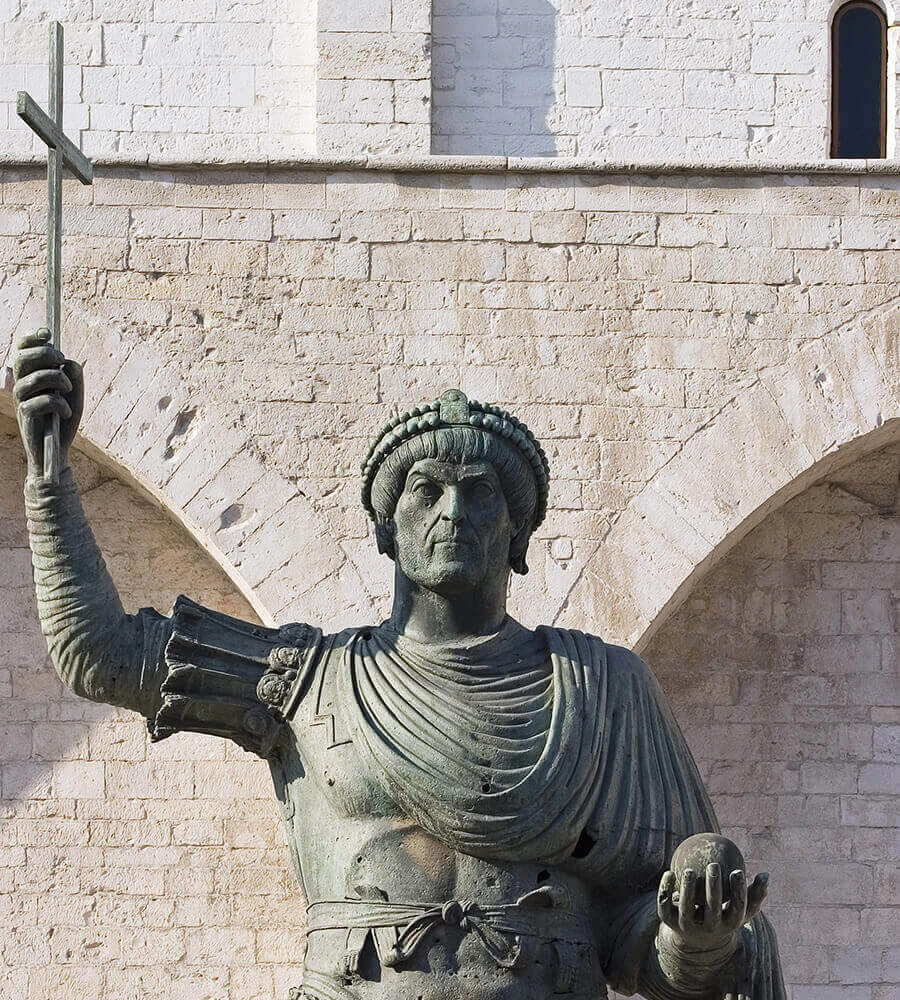
Colossus of Barletta
- 1 minute on foot
- 50 meters
The Colossus of Barletta is an imposing bronze statue from the early Middle Ages, hollow inside and 4.5 meters tall. It certainly represents an emperor, as can be deduced from its military attire, although its identity remains uncertain. Known to all as “Heraclius,” it was later also identified as “Theodosius II.”
But how did it get to Barletta? According to tradition, during the Fourth Crusade, the Venetians stole the statue from Constantinople. During the return journey, a storm caused the ship to wreck near the Barletta coast. The statue was thus brought ashore and deposited at the port’s customs house in Barletta. In 1309, an edict by Charles II of Anjou authorized Dominican friars to melt part of the statue—certainly the lower limbs—to cast the bell for the new church of Siponto. In the 15th century, some parts of the Colossus were reconstructed. In 1923, the statue was placed along the side facade of the Basilica of the Holy Sepulchre, on the stone base we still see today. After the latest restorations, completed in March 2015, the Colossus was returned to the city, accessible to the public in its original position.
It is currently the only large bronze statue from antiquity displayed outdoors in its original form, not housed inside a museum. For centuries, the people of Barletta have considered it a fellow citizen: children climb on its base, play around it, and live with it. It is part of the city’s heart.
Basilica of the Holy Sepulchre
- 1 minute on foot
- 50 meters
The Basilica of the Holy Sepulchre was erected in the 12th century. Attached to a hospitium for crusaders and pilgrims, it was administered between the 12th and 15th centuries by the Canons Regular of the Holy Sepulchre and then entrusted to the Knights of Malta, who maintained it until 1808. Despite repeated interventions, the building retains clear traces of its original structure, highlighted by restoration work carried out in the early 1970s. The roofing system features pyramidal roofs, covered with flat stone slabs called chiancarelle, typical of Apulian building tradition.
The current facade was built in 1770, following the demolition of the medieval portico in front of the church, of which some remains can still be observed (the bases of the pillars and the side arch). From the outside, on the three apses directly attached to the back wall, one can see the remains of the Baroque-style bell tower, designed in 1737 to replace the previous structure, which was demolished in 1903 for safety reasons.
The interior has three naves, divided by cruciform pillars surmounted by pointed arches and covered by cross vaults. The church preserves numerous frescoes (13th-14th century) and a rich Treasury with several valuable objects traditionally believed to come from Palestine. The most precious piece is the relic of the Cross, which contains three fragments of Jesus Christ’s cross.
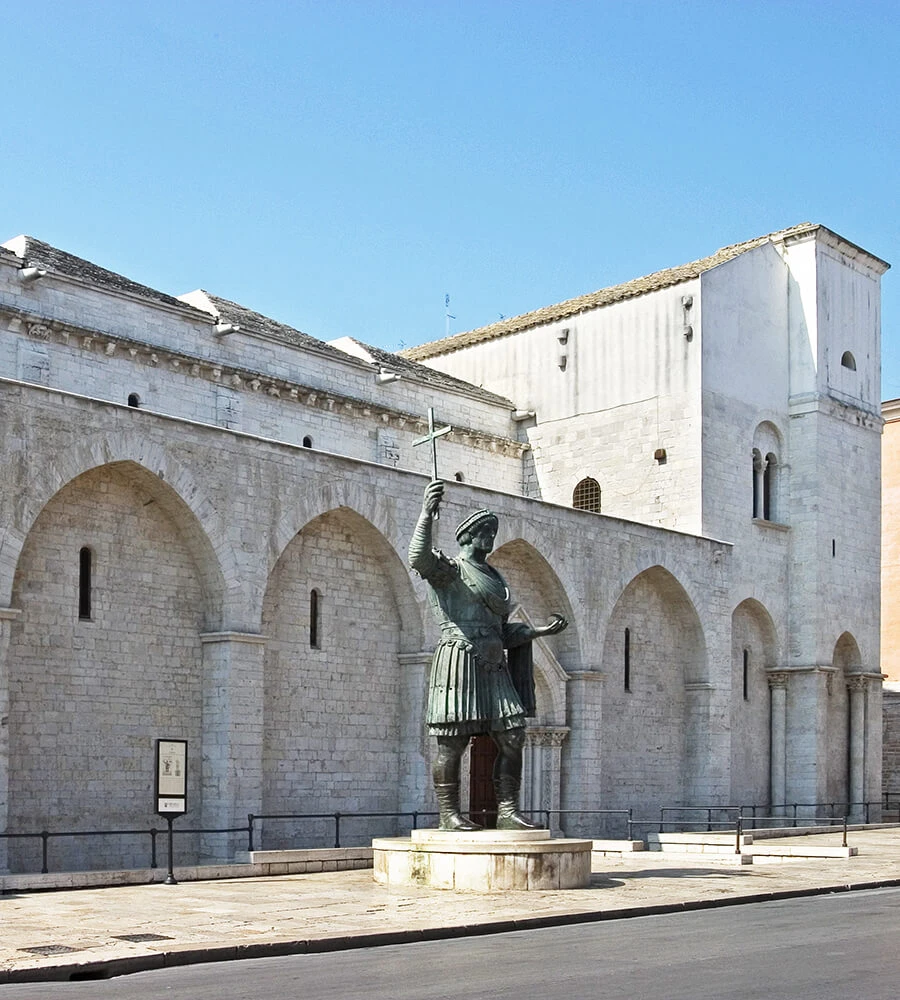
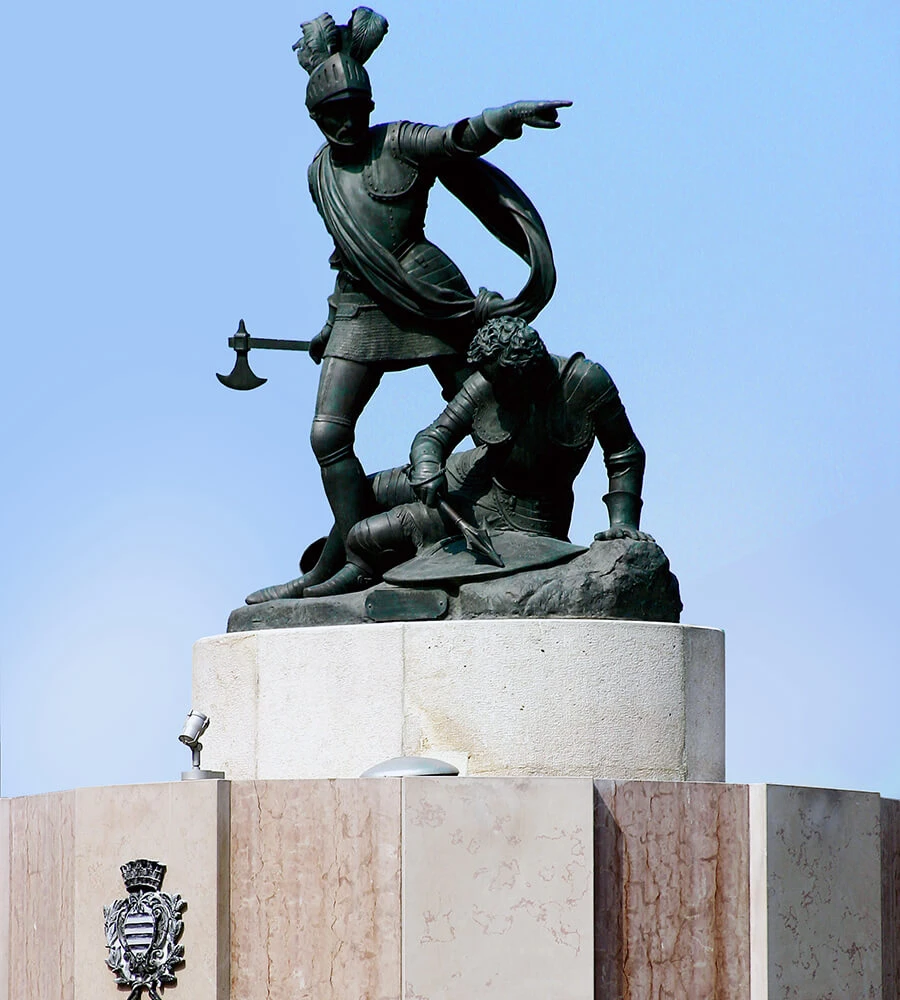
Cantina della Sfida
- 5 minutes on foot
- 300 meters
The Cantina della Sfida (Cellar of the Challenge) is an ancient medieval tavern in Barletta, dating back to the late 15th or early 16th century. According to tradition, it was here that the episode that gave rise to the famous Challenge of Barletta took place.
In 1503, while Spain and France vied for control of Southern Italy, Barletta—occupied by the Spanish led by Gonzalo Fernández de Córdoba—was the scene of clashes. During one such encounter, the Spanish captured several French soldiers, including Captain Charles de La Motte. To honor them according to chivalric customs, de Córdoba organized a banquet. During the feast, La Motte insulted the Italian knights serving Spain, calling them vile and inferior to the French. The atmosphere intensified when a Spaniard recalled that Ettore Fieramosca had unsuccessfully challenged a French knight. This time, however, the challenge was accepted: on February 13, 1503, thirteen Italian knights led by Fieramosca faced the French in a duel between Andria and Corato, winning.
Today, the ground-floor rooms of the Cantina recreate the 16th-century atmosphere: a setting furnished with period furniture and decorated with the shields of the thirteen knights. Outside, in Piazza della Sfida, stands a monumental temple inaugurated in 1930, featuring the coats of arms of the knights and a bronze plaque made in 1903 with their names. Each year, a historical procession in costume reenacts the entire episode. The model of the bronze statue at the crossroads of Piazza Castello was made in 1830 by Achille Stocchi and is now located in the Cantina.
Barletta Castle and Civic Museum
- 10 minutes on foot
- 750 meters
The first core of the Castle dates back to the Norman-Swabian era, of which the beautiful single-lancet window overlooking the east side of the Piazza d’Armi is still visible. Modified between the 13th and 14th centuries during the Angevin domination, it was radically restructured during the Aragonese period. The architectural project, commissioned by Charles V, incorporated the medieval pre-existing structures within a defensive system designed to face threats from both sea and land.
Around the Piazza d’Armi, the four sides of the building unfold, articulated on two floors. At the corners, there are four towers, characterized by hemispherical domes that are also replicated in the underground levels. The side facing the sea was occupied by the hospitium militum, the barracks, with accommodations for soldiers and the Castellan. These are small rooms directly overlooking the ramparts. The angular structures of the outer perimeter—spearhead bastions resting along the moat—enclose the outer sides of the fortress, giving it exceptional grandeur and majesty. Since 2003, the castle has housed the Barletta Civic Museum, established in the late 19th century with an initial collection of archaeological finds donated by citizens and initially placed in the Municipal Library. Within twenty years, the original core was enriched with paintings by Barletta artists: Geremia Discanno, Giuseppe De Nittis, Vincenzo De Stefano, Giambattista Calò, Giuseppe Gabbiani.
The permanent exhibition includes the Ancient Gallery, the 19th-Century Gallery, and the Cafiero Gallery. In the Ancient Gallery, noteworthy is the bust of the emperor, which some believe to be a portrait of Frederick II of Swabia, in line with his passion for the Roman world and classical ideals.
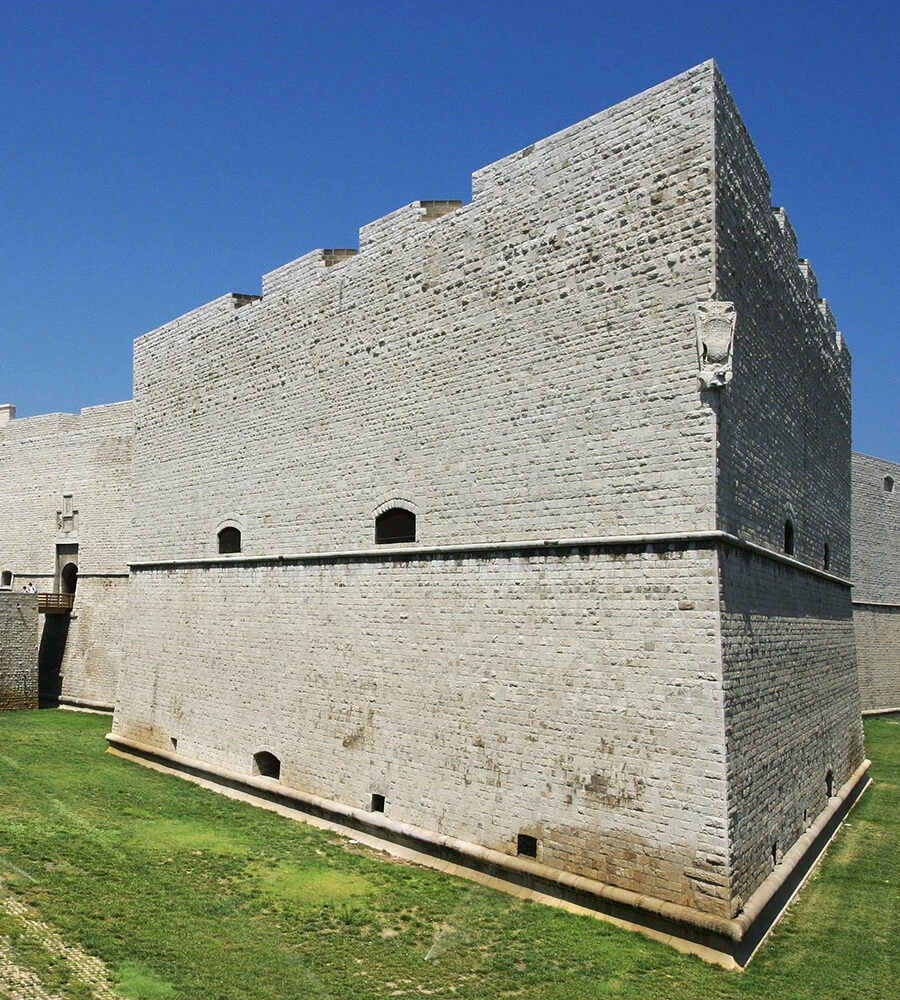
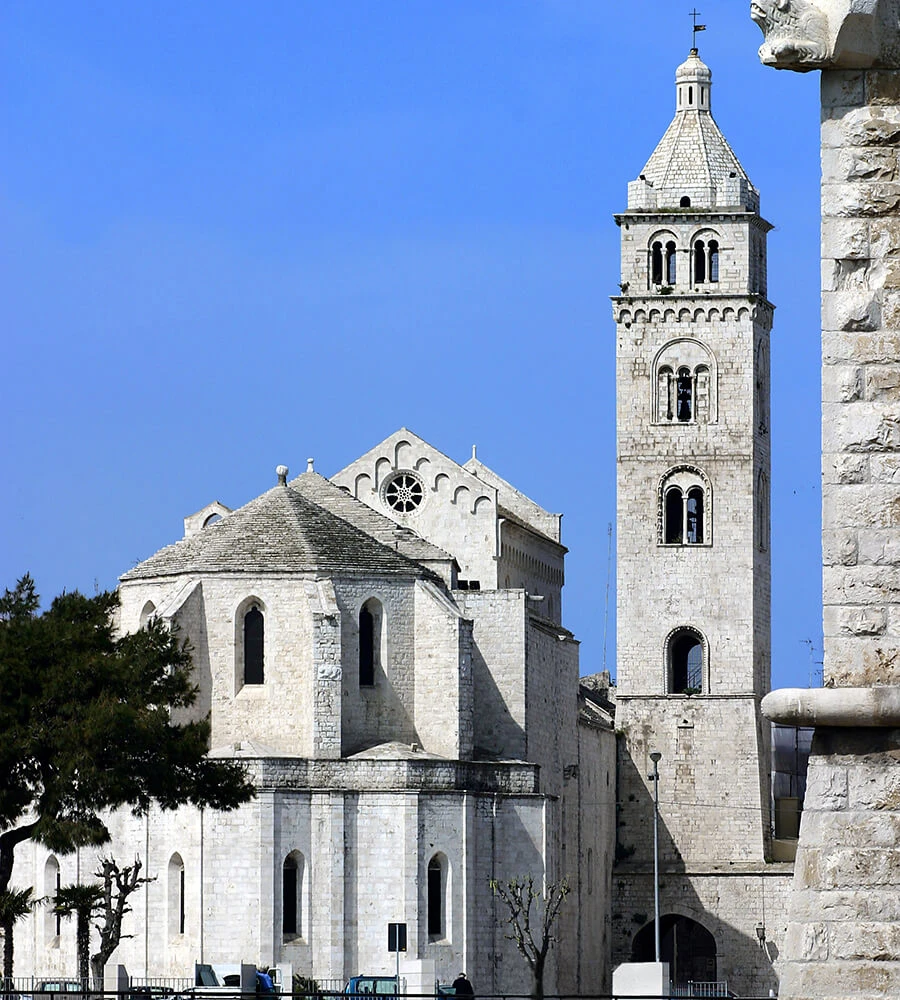
Cathedral of Santa Maria Maggiore
- 7 minutes on foot
- 500 meters
The Cathedral of Santa Maria Maggiore, located in the oldest part of the city, stands on pre-existing constructions, the result of an evolution of places of worship from different eras, chronologically outlineable as:
4th-3rd century BC: pre-Christian tombs;
6th century: early Christian basilica;
9th-10th century: early medieval basilica;
12th-13th century: Romanesque basilica (front part);
14th century: Gothic apses (rear part).
The current building is the result of various construction phases, started in the 12th century and completed in the 17th century. In the 12th century, the church was already under construction, as attested by two inscriptions. The Romanesque part, corresponding to the front section, has three naves, with a double-arch colonnade, false matroneum, and a truss roof in the central nave. It was closed by three apses, whose profile is reproduced in the current pavement. In the 14th century, the church was expanded with the addition of the presbytery, covered with cross vaults on composite pillars, and a pentagonal apse with radial chapels.
The facade, gabled and tripartite by pilasters, houses three portals: the lateral ones retain their original decoration, while the central Renaissance one replaces an older portal. Two mullioned windows, a rose window, and a single-lancet window complete the facade. The sculptural apparatus (12th-13th century) is rich in cultural references, and in the central nave, a bust and an inscription commemorate the coronation of Ferdinand I of Aragon in 1459.
Palazzo della Marra and De Nittis Art Gallery
- 3 minutes on foot
- 250 meters
The Palazzo della Marra stands on an ancient domus. In 1585, it was owned by the Orsini family and in 1633 passed to the Della Marra family, to whom much of the current structure and the rich architectural and pictorial decorations, created by Salento craftsmen, are owed. The ground floor features rustic ashlar, while numerous tuff elements enrich the facade.
The facade is striking for its large arched doorway surmounted by a scenic balcony, decorated with figures of fauns, eagles with spread wings, and the Della Marra coat of arms. A frieze with vegetal motifs and putti completes the string course cornice. On the Via della Marra side, there are other decorated entrances and balconies, while at the back, a loggia opens onto the sea, adorned with fantastic and mythological figures. Inside, there is an atrium frescoed with the Fraggianni coat of arms, a staircase with bas-reliefs of Roman emperors, and two rooms with painted wooden ceilings and 18th-century frescoes.
Since 2007, the palace has housed the “Giuseppe De Nittis Art Gallery,” dedicated to the famous Barletta painter, a close observer of Verismo and Impressionism. It exhibits works donated to the city by his wife, Léontine Gruvelle. De Nittis lived in Paris from the 1860s, where he achieved great success, particularly with the painting La strada da Napoli a Brindisi (The Road from Naples to Brindisi). He was known as peintre des Parisiennes for his refined depiction of Parisian ladies and participated in the historic 1874 exhibition in Nadar’s studio, considered the birth of Impressionism.
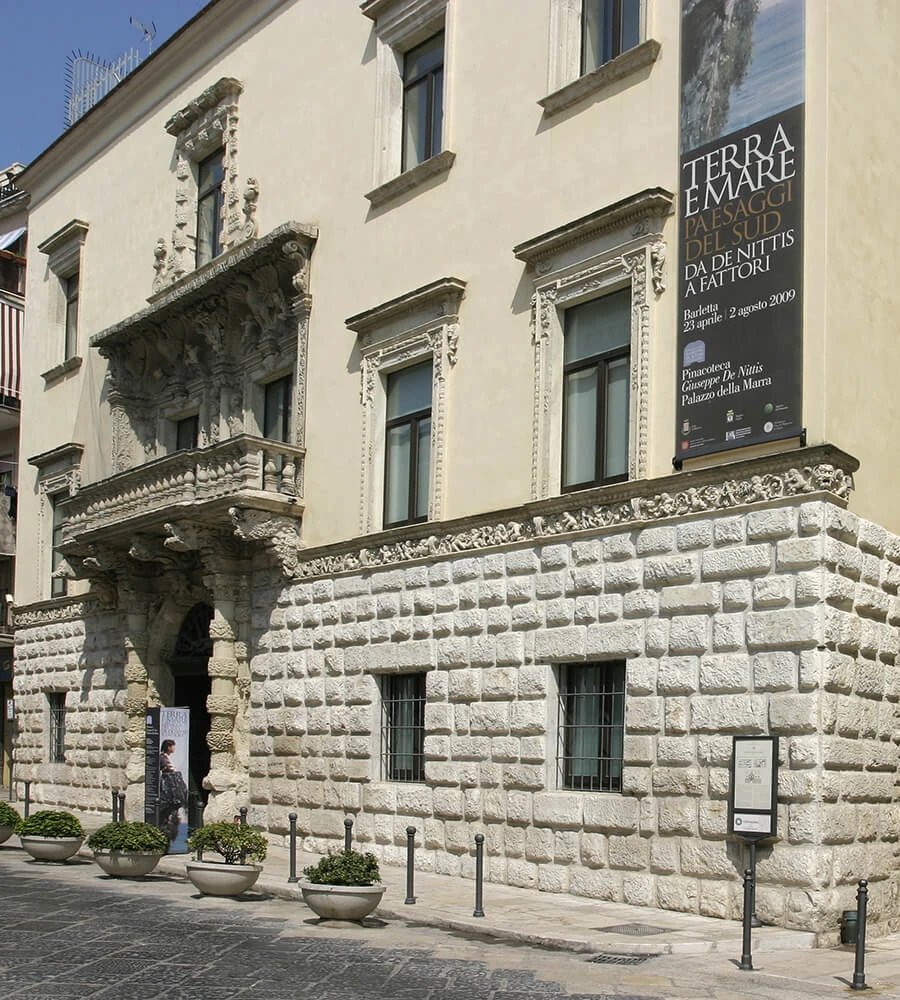
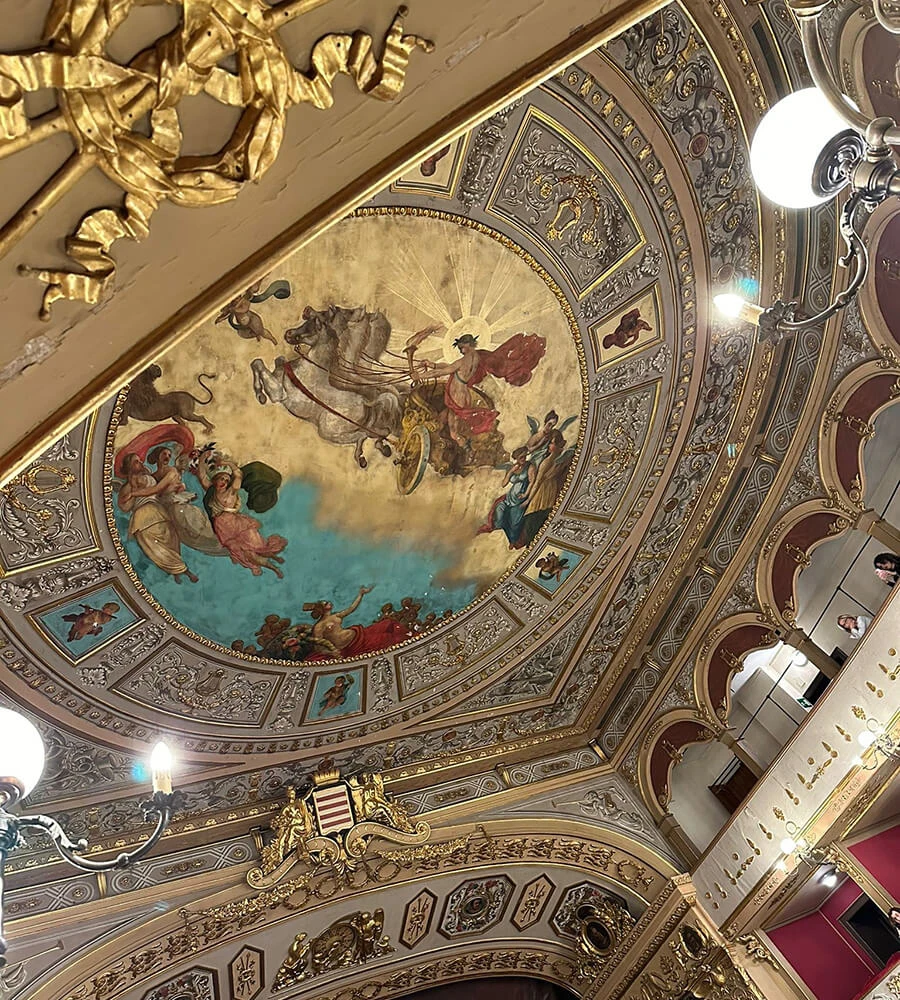
Teatro Curci
- 3 minutes on foot
- 200 meters
Walking along the main street, Corso Vittorio Emanuele II, you arrive in front of a significant building from the second half of the 19th century: the Teatro Curci. Completed in 1872 and named in 1877 after the great Barletta musician and composer Giuseppe Curci in the year of his death, it still hosts an important season of prose, music, and dance. Its excellent acoustics, the internal structures of the stalls and the three tiers of boxes plus the gallery are all made of wood; its neoclassical style, the care of the decorative elements, as well as the frescoed parts, allow us to stylistically align it with Italy’s most important coeval theaters: La Scala in Milan and the San Carlo in Naples.
It was designed by the Barletta architect Federico Santacroce, trained in the neoclassical style. In fact, the building’s facade features a pediment, Corinthian pilasters on the upper order, and a portico with three arches. Adjacent stands the Curci gallery, which at the time allowed convenient access as it could be traversed by carriages. Here, on the loggia, there was a sculptural group, now placed in the foyer where the city’s coat of arms stands out. Giovanni Battista Calò, master of the great Giuseppe De Nittis and an entire generation of painters, created the central painting of the hall, which depicts the Sun God, Apollo, leading the chariot pulled by horses, among dancing Venuses, putti, and angels—typical iconography of neoclassical art. One of the two stage curtains, depicting the famous “Challenge of Barletta,” is also a work by Calò.
The theatrical season of the Teatro Curci in Barletta is one of the main ones in the Apulian circuit. Tickets can be purchased at the Teatro Curci box office, and in some cases, also online via platform.
What to see nearby
If you’re asking what to see in Barletta, don’t miss the wonders found in the city’s surroundings. A short distance away, you can explore the majestic Castel del Monte in Andria, the evocative archaeological site of Canne della Battaglia, and the enchanting Saline di Margherita di Savoia. These places offer unique experiences blending history, nature, and culture, perfect for enriching your trip and discovering the best of the territory near Barletta.
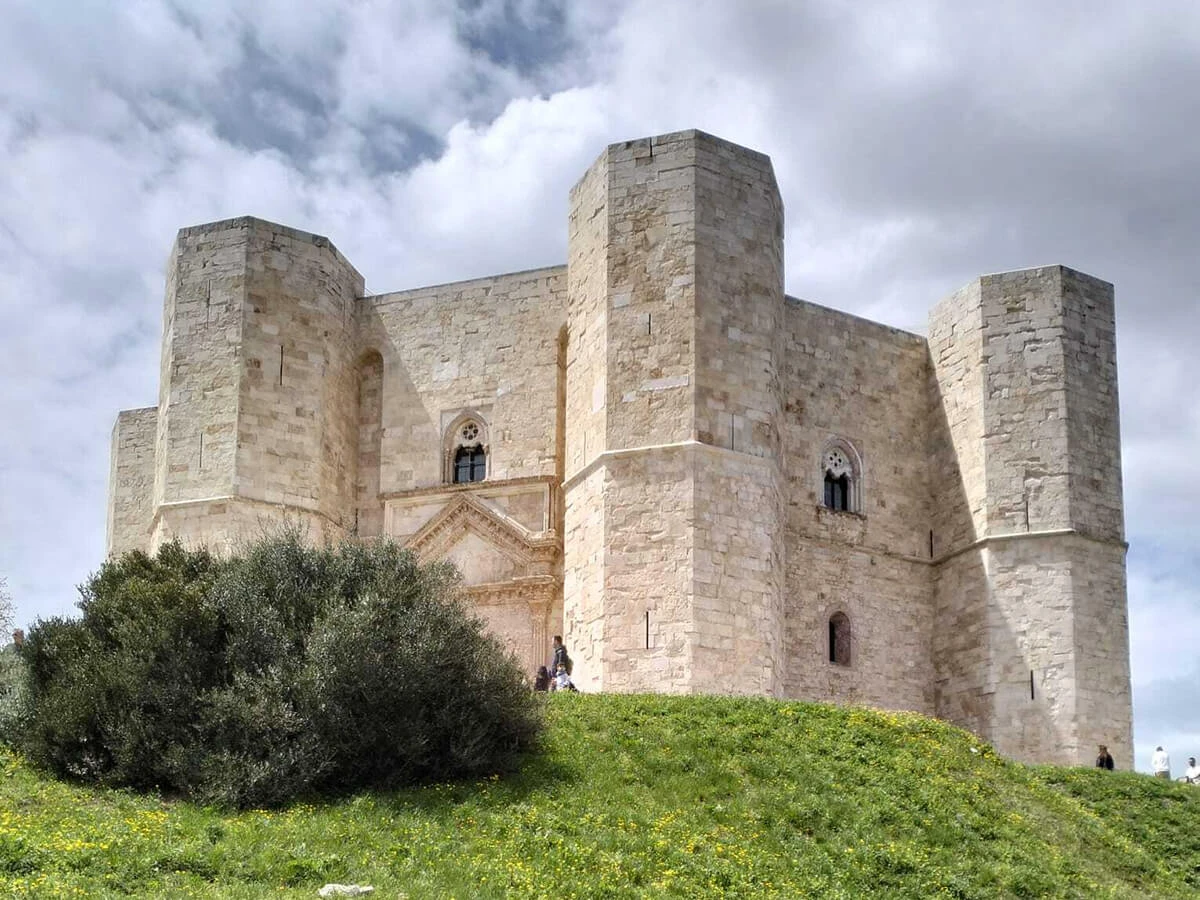
Castel del Monte
- 35 minutes by car
Approximately 35 km from Barletta, Castel del Monte is an extraordinary medieval fortress built in the 13th century by Frederick II of Swabia. Characterized by an octagonal plan and architecture that blends classical, Islamic, and Gothic elements, it has been declared a UNESCO World Heritage site.
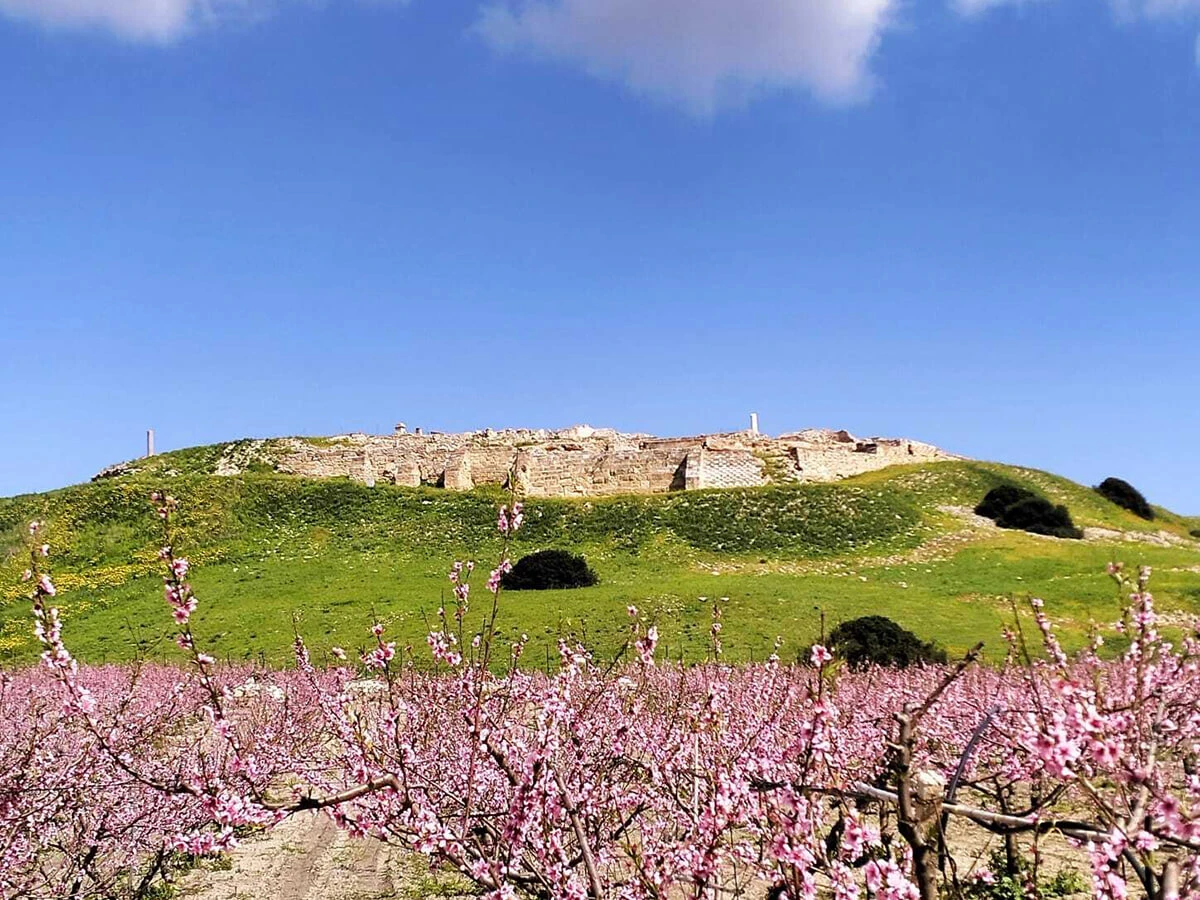
Canne della Battaglia
- 15 minutes by car
Just 10 km from Barletta, the Archaeological Park of Canne della Battaglia preserves the remains of the ancient city that was the scene of the famous battle of 216 BC, where the Roman army suffered a heavy defeat at the hands of Hannibal. The site offers a fascinating journey through ruins and breathtaking views of the Ofanto valley.
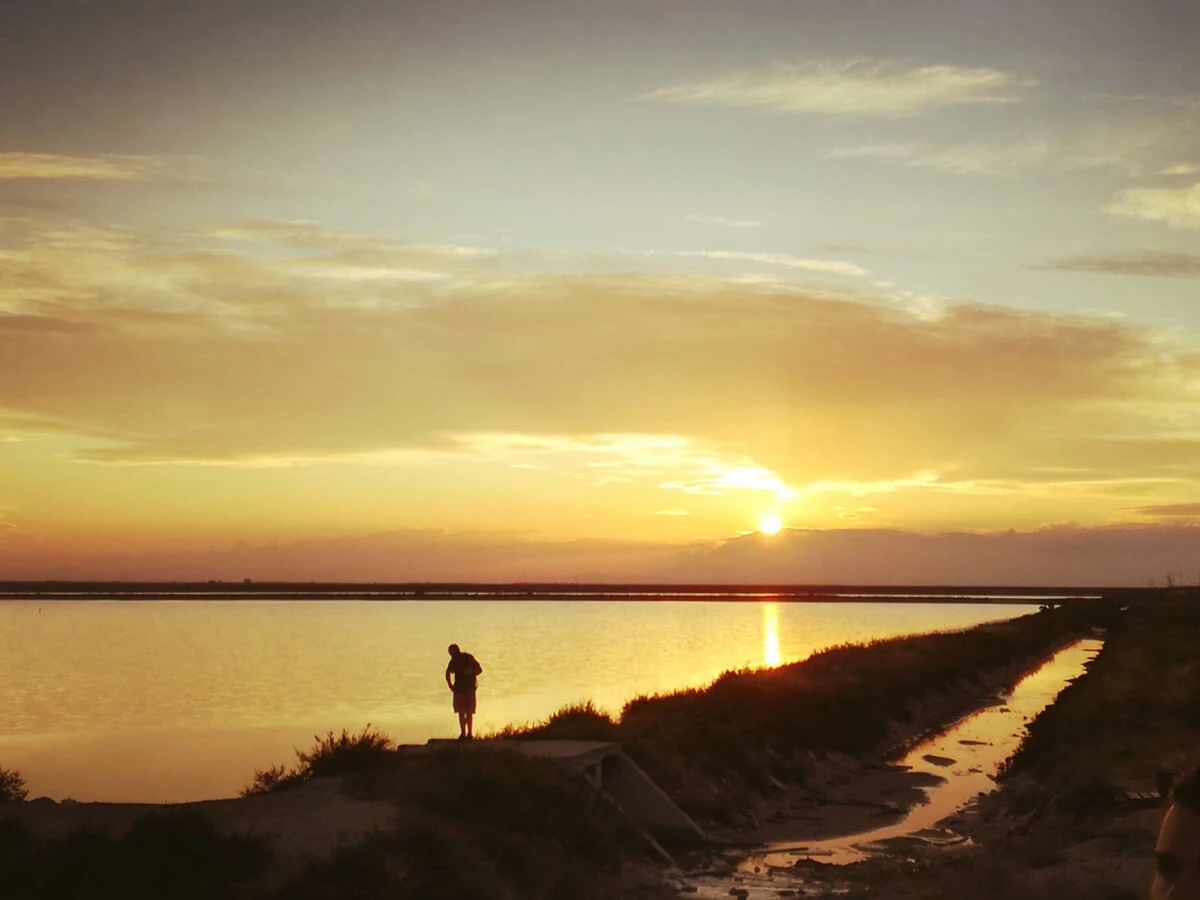
Saline di Margherita di Savoia
- 30 minutes by car
Approximately 25 km from Barletta, the Saline di Margherita di Savoia (Salt Pans of Margherita di Savoia) constitute one of the largest brackish areas in Europe, extending for over 20 km along the coast. In addition to being an important nature reserve, they are a paradise for birdwatching enthusiasts, hosting numerous species of migratory birds, including pink flamingos.
Discover what to see in Barletta: contact us for information and your stay
If you’re wondering what to see in Barletta and want to discover all the beauties of the city and its surroundings, don’t hesitate to contact us! Our B&B is the perfect solution for a comfortable and strategic stay, ideal for exploring all the main attractions on foot. Fill out the form to request information and book your stay now: we await you to give you an unforgettable experience in Barletta!